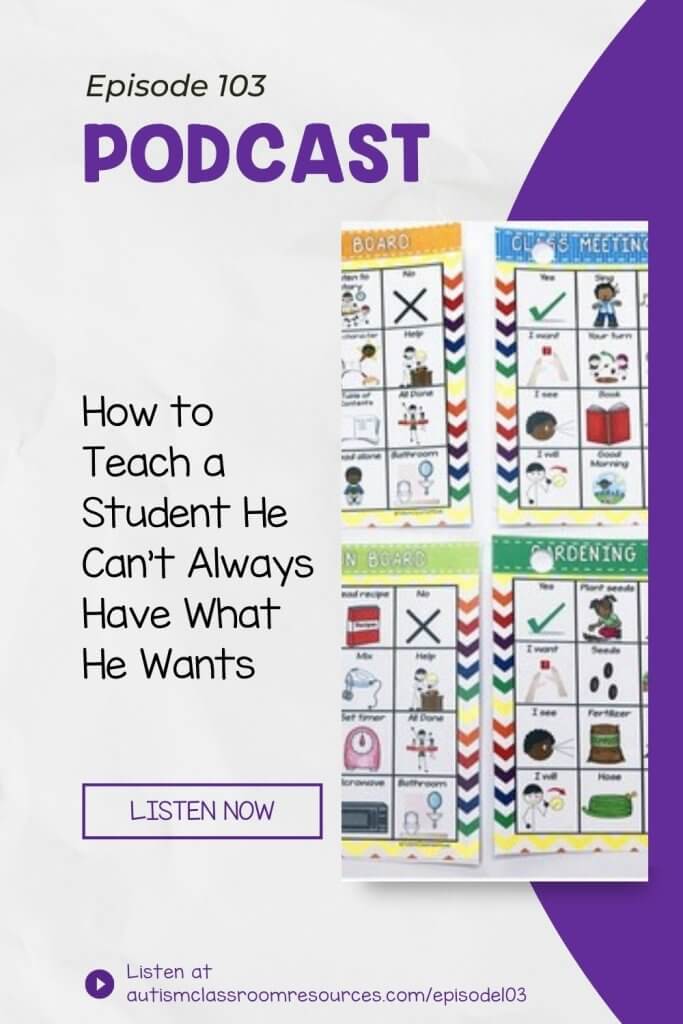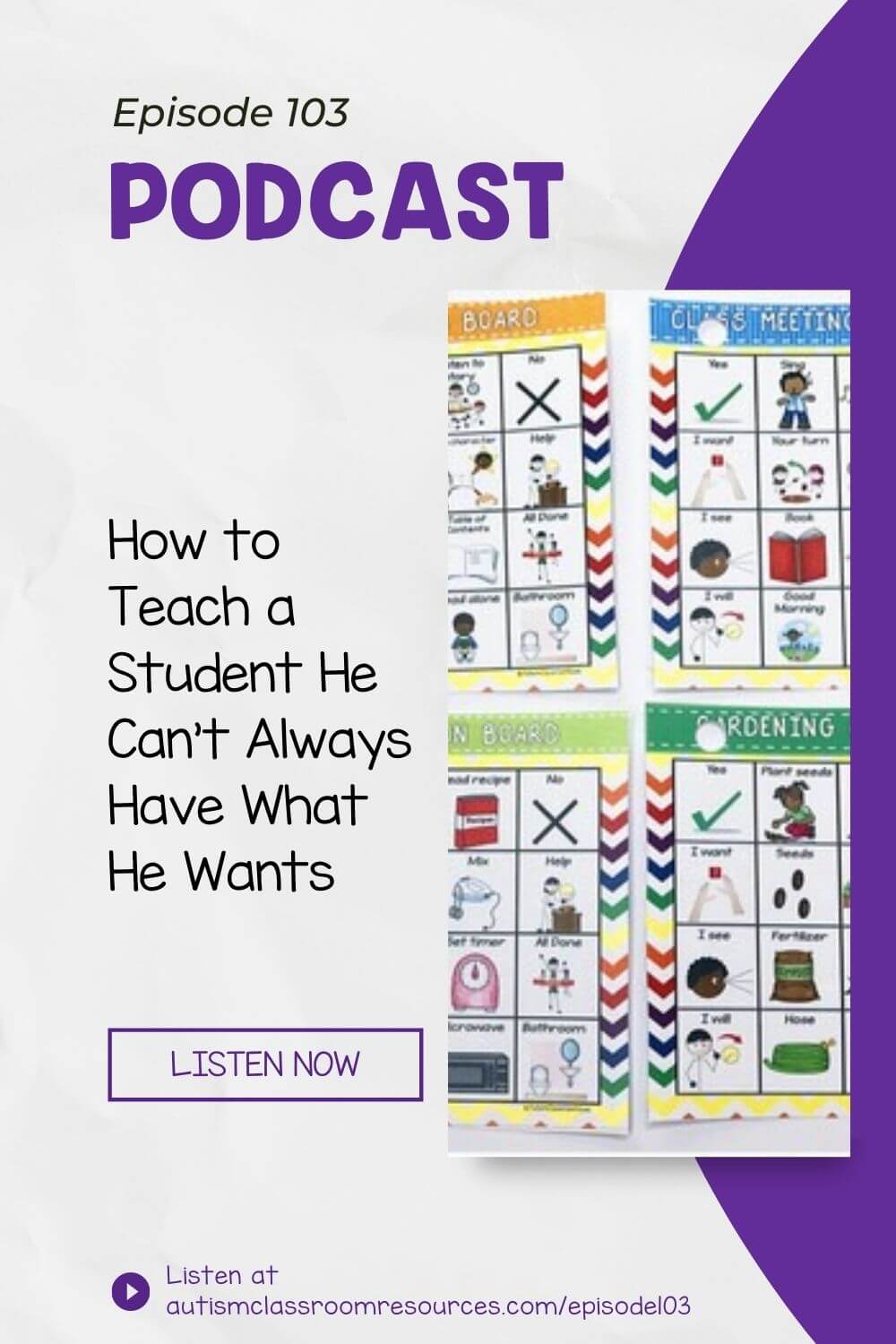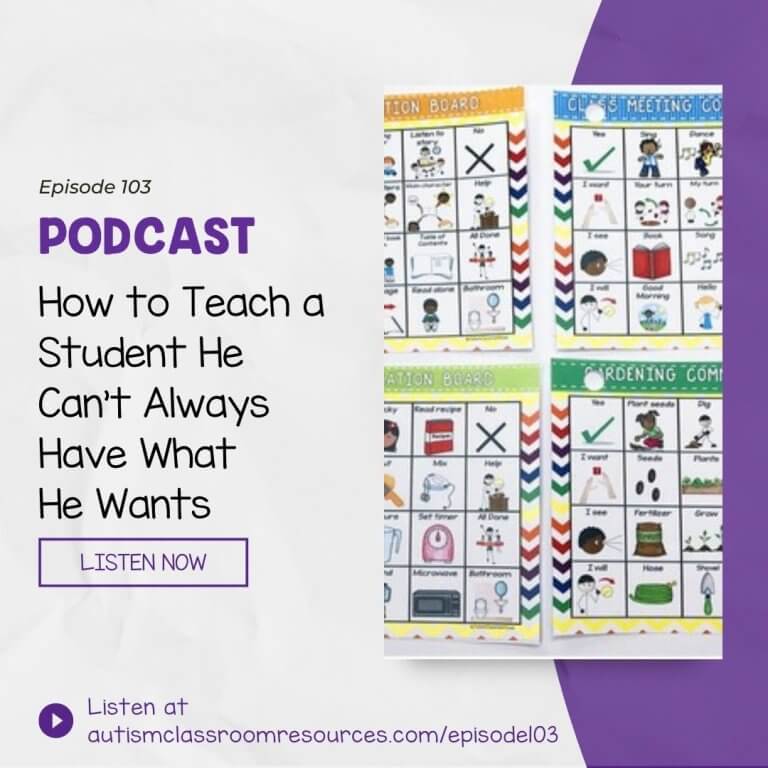Welcome to the Autism Classroom Resources Podcast. The podcast for special educators, who are looking for personal and professional development.
Dr. Christine Reeve: I’m your host, Dr. Christine Reeve. For more than 20 years, I’ve worn lots of hats in special education. But my real love is helping special educators like you. This podcast will give you tips and ways to implement research-based practices in a practical way in your classroom to make your job easier and more effective.
Welcome back to the Autism Classroom Resources Podcast. I’m your host, Chris Reeve and I’m very glad that you’re here today. Today, I am going to talk about something I hear so very often and here is how it goes. Someone will say to me, I know you say that when a student asks for something, you should give it to him to reinforce him, but you can’t always get what he wants. And yeah, you’re right, you can’t. And many times, when he doesn’t get what he wants, we get a meltdown, right? And because of that and because we know that’s the reaction, people really try to give him what he wants, right? And the cycle continues. So, you ask, what are we supposed to do because he really can’t always get what he wants. Sometimes we just can’t give it to him even when he’s asking nicely and you’re right, and that’s what we’re going to talk about today. So, let’s get started.
So, Dante is learning to ask for pretzels, his absolute favorite thing in the world with his iPad, but one day he you out of pretzels. So, what do you do? Do you send someone to the store to buy pretzels? Because you know from experience that Dante is going to have a come apart with no pretzels. Very interesting term come apart. It’s one of those things I picked up in the South and it’s very descriptive. Well, no, you aren’t going to go get pretzels or raid the room next door or call his mother. That’s all ridiculous. But tell me that you didn’t think about it because you all know this is going to be bad. Because here’s the deal. There are things that we can do and things that we should do before we get to this day. But hey, if we haven’t already started them, let’s at least start them today and see if they work. And if not, at least we’ll be on our path to preventing this problem from happening in the future.
First, let’s think about why this is happening. Sometimes it’s happening out of frustration. We’ve all had that frustration that makes us act out or at least if you’re better behaved than most of us, we’ve seen other people do it who don’t have developmental disabilities. And if you haven’t, just go to the airport over Thanksgiving break and trust me, you’ll see frustration induced behavior problems from people who typically don’t have behavioral issues. Other times, it happens because in the past if Dante persisted and got upset, the thing magically appeared. So, essentially, his behavior problem had been reinforced in the past.
So, extinction bursts work, they get reinforced. And that also happens when he thinks it’s that you don’t want to give him something instead of that you can’t give him something or he doesn’t think you understood what he was asking for and chances are good that Dante has a pretty long history of people not understanding his communication. So, it wouldn’t be too unusual that that has happened to him before. And that makes it more likely that you’re going to get that kind of reaction.
So, with all of that is the background. What should we do? Let me start with some things that we really shouldn’t do. Because sometimes we think that there are shortcuts that will solve the problem and actually make a bigger problem. First, don’t remove his communication symbol from his device or take his device away from him completely. My general rule on taking devices away from students is this, if you couldn’t take the student’s voice away, you shouldn’t take their device away because they are the same. They serve the same function. Imagine how demoralizing it is when someone silences you even temporarily in a meeting like a faculty meeting.
Now, imagine if they could actually take your voice from you, that shouldn’t happen to our students. This often seems like a really easy fix to eliminate the issue. And I’ve worked in programs where it happens before we walk in and the kid’s communication devices in a container where he can’t access it because people thought that was easier. But it doesn’t solve the problem. Instead, it teaches him that he can’t rely on his voice to be there when he needs it. And it teaches him that behavior problems are his most reliable method of communication and we don’t want that. Also, don’t just give him the item unless you factored that into the plan. So, you may have part of your behavior plan that you give him the item he wants at certain times of day to avoid having the day result in a meltdown. And that’s fine. As long as you factor that into the plan, you have to decide how to balance keeping students engaged with your learning goals versus managing behavior, but in Dante’s particular case, if you’re out of pretzels, then that isn’t even going to really be a relevant choice.
So, what can you do? So, those are the things what not to do. What can you do? First, hopefully, before you get to a time like this when you don’t even have the pretzels, once Dante learned that he could reliably request pretzels on his own. He got to a point where you started to teach him to wait for them for short periods of time. Sometimes we forget that part of the instruction, we get so excited that he learned to ask that we forgot to teach him that he couldn’t have it every time he asked. So, we forgot to teach him that waiting component. So, we have to start teaching him to wait for short periods of time. That way, we’re starting to teach him to delay that reinforcement and then we can also work our way up to learning that he won’t get it at all sometimes when he asks and I have a post about teaching students to wait and a link to that into the post for this episode at autismclassroomresources.com/episode103.
When you are teaching waiting or you’re teaching him that he can’t get something. You want to start with less preferred items first. Don’t start with the pretzels for Dante. Maybe start with cheese crackers because he likes them, but they’re not as exciting as pretzels for him. So, that’s going to reduce the challenging behavior that comes when he doesn’t get it those first times. So, it makes it easier to tolerate the denial and it’s going to make it easier for him to see how that waiting works so that once he sees that he is eventually going to get it and how it works, it’ll be easier for him to tolerate it when you get to teaching it was the stuff he really likes like pretzels.
One way to work on learning that he can’t get something that he asks for or something to try during this particular situation with Dante even if you haven’t already started this process is to show him empty container. So, an empty pretzel container. So, keep a store of empty containers of his favorite items around so you can show them to him or to the student so they can see that there are empty. This helps them know that something isn’t available and it helps explain why you aren’t giving it to them. Even if you know that you have a secret pretzel stash that they don’t know about. You could also put the thing he wants like a pretzel in a parking lot and a parking lot is typically a clear container does the student can see where either he or you park the item, the thing that he wants, and then you can put a timer on it and let him know when the parking lot is going to open up.
And I have a post on how you can use parking lots for perseveration on the blog that I’ll link to in the show notes and they work pretty much the same way. The only difference is you’ll be putting it probably in the parking lot as opposed to the student putting it there but it’s the exact same concept. You’re putting it there for a temporary time. You’re letting him know that you’re not taking it away forever. He can see that he’s going to get it at a specific time. Another thing that you can try that you can do with the AAC device so you’re not going to take it away from them, you’re not going to take that symbol off of it, but depending on the device, you can’t do it with all of them. But with some of them, you could put a universal no sign or an X over the picture or the word for the desired item.
Now, you’re not going to silence the voice on the device or cover it up completely or remove the item from the device. So, you’re not taking it away. You’re simply putting a symbol on top of them to let him know that no, it’s not a choice. If he presses on it, it will still say pretzels. He will still see it there on the board, but the no symbol helps him know that it isn’t available right now. So, those are some things that we could try to help Dante work through the frustration of not getting what he asked for. The key is to try to balance the reinforcement of the requesting with the reality that what he wants isn’t always going to be available.
So, we always have to start our instruction with this in mind and not just get stuck at the requesting stage. The next stage of teaching waiting is going to be equally as critical because you’re right, he can’t always get what he wants. You’ll find all the links for waiting and parking lots that I’ve talked about LinkedIn. The post for this episode at autismclassroomresources.com/episode104, and if you’re really struggling with student’s communication and behavior, come join us in Special Educator Academy with a seven-day free trial. We have a full course in both communication instruction and another one in behavioral problem solving plus we have tons of short videos and quick wins that can help you with students just like Dante. Come and put the joy back in your teaching this year and let us help you feel more confident in your classroom.
All you have to do is hop over and sign up for your seven-day free trial at specialeducatoracademy.com. I hope you’ll come back for another episode next week. And until then, I’ll just be sitting here singing The Rolling Stones, You Can’t Always Get What You Want to myself because that’s not going to get out of my head anytime soon.







